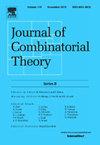A characterization of the Grassmann graphs
IF 1.2
1区 数学
Q1 MATHEMATICS
引用次数: 0
Abstract
The Grassmann graph is a graph on the D-dimensional subspaces of with two subspaces being adjacent if their intersection has dimension . Characterizing these graphs by their intersection numbers is an important step towards a solution of the classification problem for -polynomial association schemes, posed by Bannai and Ito in their monograph “Algebraic Combinatorics I” (1984).
Metsch (1995) [37] showed that the Grassmann graph with is characterized by its intersection numbers except for the following two principal open cases: or . Van Dam and Koolen (2005) [57] constructed the twisted Grassmann graphs with the same intersection numbers as the Grassmann graphs (for any prime power q and ), but not isomorphic to the latter ones. This shows that characterizing the graphs in the remaining cases would require a conceptually new approach.
We prove that the Grassmann graph is characterized by its intersection numbers provided that D is large enough.
格拉斯曼图的表征
格拉斯曼图 Jq(n,D) 是 Fqn 的 D 维子空间上的图,如果两个子空间的相交维数为 D-1,则这两个子空间相邻。Metsch (1995) [37]指出,D≥3的格拉斯曼图 Jq(n,D)由其交点数表征,但以下两种主要开放情况除外:n=2D 或 n=2D+1。Van Dam 和 Koolen(2005)[57] 构建的扭曲格拉斯曼图与格拉斯曼图 Jq(2D+1,D)(对于任意质幂 q 和 D≥2)具有相同的交点数,但与后者不同构。我们证明,只要 D 足够大,格拉斯曼图 Jq(2D,D) 的交点数就是它的特征。
本文章由计算机程序翻译,如有差异,请以英文原文为准。
求助全文
约1分钟内获得全文
求助全文
来源期刊
CiteScore
2.70
自引率
14.30%
发文量
99
审稿时长
6-12 weeks
期刊介绍:
The Journal of Combinatorial Theory publishes original mathematical research dealing with theoretical and physical aspects of the study of finite and discrete structures in all branches of science. Series B is concerned primarily with graph theory and matroid theory and is a valuable tool for mathematicians and computer scientists.

 求助内容:
求助内容: 应助结果提醒方式:
应助结果提醒方式:


